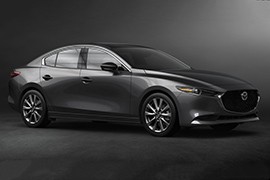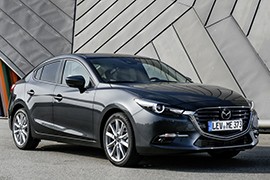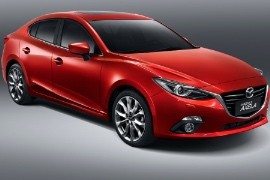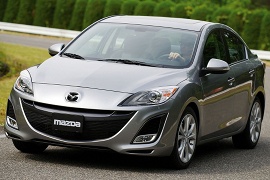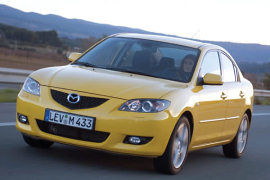MAZDA 3 / Axela Sedan Models/Series Timeline, Specifications & Photos
First production year: 2004
Engines: Diesel, Gasoline
The fourth generation of Mazda 3 was introduced in 2018 and it followed the Kodo design language, showcased by the RX-Vision concept in the 2015 Tokyo Motor Show.
The compact-segment was one of the most important in more markets around the world. From mass-market brands to premium brands, every car-maker had at least one member there. It was the market were a hatchback, a sedan, a station-wagon, a coupe or a convertible could find a place and a buyer. Mazda chose to launch only a 5-door hatchback and a sedan for the Mazda 3 in that segment.
The Kodo design language was like a flowing metal in motion. And the 3 was just like that. The swept headlights, the flowing lines, and the short deck confirmed those principles. The sculptured door panels were flowing, following the air-stream.
Inside, the 3 featured a double level design and the 8.8” infotainment screen rising up in the middle. The center stack hosted only the climate control buttons. On the center console, the designer installed the commander control, a rotary knob.
The 3 featured a choice of engines ranged between a 1.8-liter diesel and 2.5-liter gasoline. All versions were assisted by the Mazda's new M Hybrid system, which increased fuel-efficiency and driving experience. The standard transmission for the entire range was a 6-speed manual, while a 6-speed auto was on the options list. The platform offered a front independent suspension and trailing arm in the rear. An all-wheel-drive version was available as well, but still without an independent suspension in the back.
Mazda refreshed the third generation of the 3 / Axela lineup for the 2016 model year, and it produced it in both shapes, as a sedan or a hatchback.
After its separation from Ford Motor Company, Mazda's engineers started to work harder to create new products based on their own experience and developments, not on those provided by the American automaker. That was a good thing because it helped the designers become more creative. Thus, they created the Kodo lines, which were characterized by fluid lines and sharp angles, but in a different way than any other automakers on the market. Moreover, there were some changes on the mechanical side as well. While for most markets, the compact-sized vehicle was known as 3, in Japan, it used the Axela nameplate.
With its swept-back headlights and big, shield-like grille at the front, the 2016 3 / Axela sedan looked not just young and fresh but also sporty. From its profile, the curved lines sculptured on the doors resembled those from the 3's biggest sibling, the 6. Unlike its hatchback stablemate, the four-door version featured a short deck behind the rear windscreen and the thick C-pillars.
Inside, the automaker installed an improved dashboard, which sported an infotainment screen that followed the floating-design trend. It looked like it was mounted there after the car left the assembly lines. Yet, it was easy to control via a rotary knob placed on the center console. At the front, the bolstered bucket seats provided some side support during high-speed cornering, while at the back, it had just enough room for two adults but was limited for a third, middle-seated passenger.
Under the hood, the Japanese automaker installed a choice of five diesel and gasoline engines, depending on the market.
Mazda unveiled the third generation of the 3 in 2013, and it was an entirely new car, developed after the carmaker divorced from Ford.
The 3 was an appreciated compact-segment contender globally. The car was available on all the markets, from North America to Australia, from Japan to Germany. It was a global success, and the carmaker didn't want to lose that advantage. When it built the 2013 model, Mazda's marketing department proved that it did its homework. The sedan was mostly addressed for young couples, with or without children.
Mazda 3 Sedan was shorter, wider, and lower than its predecessor. Its bodywork was stiffer by 28 percent, meaning that it aimed at sportier compact sedans, especially since it was one of the lightest cars in its segment. The curved lines expressed by the new design language, named Kodo, showed a shield-like grille at the front with horizontal slats. Its eye-like headlights showed an aggressive styling. From its sides, the sculptured door panels and fenders followed strict principles and led to an excellent aerodynamic coefficient of just 0.258. Its cab-rearward design, with a short and tall trunk, had a significant contribution to that.
Inside, the carmaker followed the minimalism design concept. Its dashboard was simple, plain, with only a few buttons on sight, on the center stack. A floating infotainment display was in the middle of the dashboard, and the driver could access it from the steering wheel's buttons or from the rotary knob placed on the center console. The front bucket seats were designed to win a beauty contest, and their minimal bolstering reminded the front occupants that it was a family car. In the back, the three-seat bench offered two Isofix anchoring points.
Under the hood, Mazda installed its latest developed Sky Active engines. The 3 was offered with a choice of two gasoline and two diesel engines.
Soon after the breaking up its ties with Ford, Mazda started to rebuild its entire lineup, and the 2009 Mazda 3 was an important range.
The 2009 Mazda 3 was based on the previous model, developed together with Ford. But the changes brought for the model were extensive and important.
The outside look was in the Japanese's design Zoom-Zoom philosophy. It had the look of a compact sports sedan, and the platform to back-it up. Some of the important improvements over the previous generation were the standard introduction of the ABS on all the range, starting from the base trim level. For the sedan, a remote-control trunk opener was added, to complement the key opening method. The Mazda 3 sedan offered a self-leveling bi-xenon headlight with the Adaptive Front Lighting System. It was the first compact-class sedan to offer such an advanced system.
Inside the vehicle, a new dashboard with higher quality materials was installed. Some of the buttons and controls were rearranged for better ergonomics. A Multi-Information display was installed on top of the center console. It included navigation, audio, and trip computer information.
For the U.S. market, the Mazda 3 Sedan offered two engine choices, while in Europe the car was offered with a wider choice, both diesel and gasoline units. On the North-American continent, the Mazda 3 was fitted as standard with automatic transmission on the top, 2.5-liter engine.
Mazda dropped the 323 range and replaced it with the Axela/3 in 2003 for the Japanese market followed by an international presence in 2004.
The car shared its platform with the European Ford Focus Mk2, which was not available in the U.S. Mazda used the Axela name in Japan, while 3 was used for the rest of the world. It was available as a five-door hatchback or as a four-door sedan.
Mazda followed the new-edge-design concept when it introduced the 3. The pentagonal-shaped grille sported two body-colored and Mazda's chromed badge. Following the sporty design, the bumper featured a center grille at the bottom flanked by two side scoops for the fog lights. In the sedan shape, the carmaker didn't use the same rear doors as the hatchback. The thick C-pillars were raked forward and followed by a short trunk lid with an option for a lip-spoiler, depending on the trim level.
Inside, the 3/Axela featured a curved dashboard with three individual clusters for the instrument panel, with the speedometer in the middle and the tachometer on the left. The right side was for the coolant temperature, fuel level, and a small, monochrome LCD. Its front bucket seats with decent side bolstering provided good lateral support for its occupants, while the rear bench was suitable for two adults and a child in the middle. Thanks to its split-folding seatback, the trunk size could increase from 413 liters (14.6 cu-ft) to 675 liters (23.8 cu-ft).
Unlike most of the cars in the segment, the 3/Axela sedan featured independent suspension in all corners. Its Mazda-designed platform helped her be one of the best in its class for cornering speed, but its engines were designed to help families budgets, not performance.
